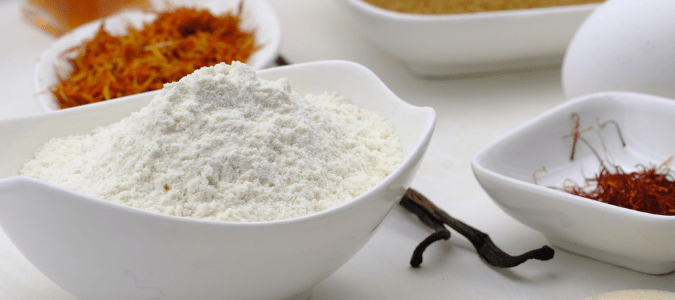There’s a wide range of bugs that you might find in the food in your pantry. They might invade food items and dried goods like flour, tea, nuts, seeds, rice, crackers, chocolate, dried fruits, spices, pasta and powdered milk. While most of these bugs won’t bite you or otherwise damage your home, they can ruin the food in your pantry. And, not to mention, they can be tough to get rid of if a population becomes established.
Sometimes, the problem can be dealt with by throwing away the infested package. However, if the infestation grows, the best way to treat these pests is to contact a professional. These pros have the experience needed to best identify what kind of pests are in your pantry. Then, they can help you understand your options for treating the infestation.
If you have found bugs in your flour, you likely have a lot of questions. But first, it’s important to identify which pantry pest you’re dealing with.
Weevils
One of the most common types of bugs that infest pantry foods are weevils. Weevils are tiny beetles less than an eighth of an inch long. While people sometimes call any beetle that they find in their pantry a weevil, these pests mostly feed on whole grains instead of processed products.
The type of weevil that feeds on grains, seeds, rice and maize has an extended snout. The type of weevil that feeds on peas and dried beans are a bit smaller and don’t have a long snout. However, since they’re so small, you’ll likely just notice brown specks in pantry items. Weevils can be particularly difficult to deal with because they don’t just eat grains—they also lay their eggs inside of food. Once the eggs hatch, the larvae eat through the bean or grain kernel they were born in and continue to multiply inside your pantry.
Weevils can get into your home in a number of ways. They can infest grain while it’s in the field or in bulk storage. The most common way they get to the pantry is through infested products. Weevils might come to a grocery store inside a package of food and then spread to other items on the shelf. Once you buy an infested product and bring it home, the weevils can invade other food in your pantry. They can do this by flying to open packages, crawling through the seams in a package or chewing through unopened packages.
Weevils are medically harmless and likely won’t hurt you if you eat them, but it can still be gross to find bugs in your food. Unfortunately, if you find an adult weevil in a package, it’s possible that they have infested the entire package. And, there could be weevil eggs waiting to hatch in the food.
If you know a package is infested, it’s best to throw the whole thing out. Also, it’s important to act quickly to prevent the infestation from spreading any further. Otherwise, weevils might continue to pester you. If you don’t wipe out the weevil population in your home, then adult weevils can continue to multiply.
The best way to stop a weevil infestation is to place any remaining packages of dried food in your freezer for at least four days. This should be enough time to kill off any larvae that might be in these foods. After you have cleared all your food off the shelves, vacuum the shelves, paying particular attention to any cracks and crevices. Next, wash the shelves with soap and hot water and let them dry completely before you put food on them again.
To prevent weevils from getting into your pantry, you can inspect your food before bringing it into your home. As an added measure, you can also put any dried foods that you buy in the freezer after you get home. Then, leave the food in there for at least four days. Even after the four days have passed, you can continue to store these foods in your freezer or refrigerator. Or, you can store these foods in sturdy containers on your pantry shelves. Sealable containers made from heavy plastic, glass or metal can help protect your food from weevils.
Flour Beetles and Grain Beetles
Like weevils, grain beetles and flour beetles can also get into your home via infested products. However, unlike weevils, these types of beetles can’t chew through whole grains. Instead, they feed on flour and other ground or processed foods like cornmeal, spices, pet food, chocolate, shelled nuts, cake mix, cereal, pasta, seeds and dried fruit. They can also eat bits of food that other pests like weevils have destroyed.
Flour and grain beetles are very small, so they can crawl between the folds and creases of improperly sealed containers. Similar to weevils, it typically isn’t harmful if you accidentally eat a flour or grain beetle, but it can be disturbing. Beyond destroying food, these beetles can also encourage other problems like mold growth.
The best way to get rid of grain or flour beetles is to throw away all infested food products. Then, vacuum and wash your shelves. These beetles are particularly attracted to broken down pieces of food, so they could be living in a package at the back of your pantry. That’s why it’s also good to clean out your pantry on a regular basis. Throw away food that you’ve had for a while and store any type of vulnerable food products in sturdy, well-sealed containers.
Ants
Another common type of pantry pest is ants, although not all ants are alike. The most common types of ants that you might find in your pantry are pharaoh ants (sometimes referred to as sugar ants) or rover ants. Pharaoh ants are generally orange, while rover ants are a very dark brown color.
On the bright side, the types of ants that get into your pantry usually don’t bite. However, ants can carry diseases and bacteria like Staphylococcus and Salmonella. For this reason, it’s usually a good idea to throw away any food that ants have infested.
Generally, ants come into the house looking for water or food sources, including flour and other dried foods. So, it’s important to store foods in sealed containers and clean up any spills. If you already have an ant infestation, it’s best to contact a pest control professional.
Indian Meal Moths
Indian meal moths are small off-white critters with gray or reddish-brown wings that can create a particularly gross—although harmless—infestation. They lay eggs in grains in the field and in dried foods while they’re in storage. These moths usually get into the home through infested packages of food, but they might also fly into your house.
While the moths themselves typically don’t feed on pantry foods, their larvae eat the food and often also form protective silken tunnels in the food. You might have an Indian meal moth infestation if you find off white or yellowish caterpillars in your pantry or silk webbing on or near your food. To get rid of moths, throw away any contaminated food and clean off your shelves.
Dealing with any kind of bugs in your pantry can be offputting. If you can’t seem to get rid of the bugs in your pantry, a professional can help by creating a pest treatment plan. That way, you can go back to your normal routine.
How Do Bugs Get in Flour?
Flour bugs most often get into homes through infested products. If you buy a package at the grocery store that’s infested with bugs, then these pests can spread to the rest of your pantry. Beyond flour, these pests are also attracted to a range of dried foods like spices, rice and beans. Additionally, many of these bugs can chew through common packaging materials like cardboard.
Once a flour bug gets in your home, these pest populations can grow out of control if they are not dealt with. At the first sign of infestation, it’s best to contact a professional. Professionals can identify the pest and then get to work on treating the infestation.
How to Store Flour to Prevent Bugs
One of the best ways to prevent bugs in your pantry is to carefully inspect food packages for pests before purchasing them. Also, store flour and other dried foods in well-sealed containers made of sturdy materials. It’s also important to clean food storage areas to make sure there aren’t spills or bits of food that might attract pests. These steps can also be helpful for getting rid of a roach infestation.
If you do notice bugs in your pantry, a pest control specialist can help. Many kinds of pests look alike. A trained professional can help identify and treat the pest infestation before it gets any bigger.
ABC Can Get Rid Of Those Pesky Pantry Bugs
Dealing with bugs in your food sources can be a huge nuisance. Instead of dealing with an established pest infestation on your own, contact ABC Home & Commercial Services. Our specialist can identify the pantry pest you’re dealing with and then make a plan to eliminate these pests.



